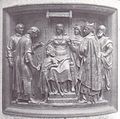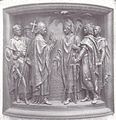Bernwards Monument
The Bernwards Monument is a larger than life bronze statue of Bishop Bernward von Hildesheim on the cathedral courtyard in Hildesheim . It comes from Ferdinand Hartzer and was created to mark the nine hundredth anniversary of the enthronement of St. Bernward set up as Bishop of Hildesheim in 1893. It was given a new location and base in 1955. Since the cathedral renovation in 2011-2014, the monument has stood in the middle of the northern cathedral courtyard.
Lineup
Original lineup
The Bernwards monument originally stood roughly in the middle between the cathedral and the bishop's house and from there dominated the northern, so-called Great Cathedral Courtyard on its three-meter-high plinth . The large Bernwardin Christ column had stood in the same place until 1893 , before it was moved to the south arm of the cathedral for conservation reasons.
The base made of light gray granite showed neo-Romanesque architectural elements and was divided into several tapering floors of different shapes. Four bronze reliefs were set into the rounded center , the front one with the name and the episcopal years of Bernwards, the other three with key scenes from his life, which showed him as an educator, a prince of the church and as an artist and were stylized to reflect the current message of the monument . Immediately below the figure of the bishop there was a replica of the Bernward cross , which explains why this main classic Bernward attribute is missing from the statue itself.
The bronze parts of the base were removed and melted down for war purposes as early as 1943. The statue itself was stored and survived the destruction of Hildesheim. After the war, the cathedral chapter decided not to put them back on the old substructure. This was removed in 1966.
1955 to 2011
In the course of the reconstruction of the cathedral, which was destroyed in the war, the statue was placed on a wide cubic base made of roughly hewn natural stone on the forecourt of the northwest entrance to the cathedral. Anyone approaching from the east (city side) went head-on to the bishop's monument and was greeted by him, as it were, before entering the cathedral. The terrain rose behind the base almost to its height; a staircase next to the monument overcame this difference in height and made it possible to come approximately on the same level as the bishop.
In September 2011, the Bernward statue was temporarily moved to the garden of Domhof 24 as part of the cathedral renovation .
Since 2014
After the cathedral renovation, the monument was erected on the green space of the Great Cathedral Courtyard northwest of the northern paradise with a view of the cathedral on a flat, rectangular monolith .
Description of the statue
The bronze picture, meanwhile covered with patina and drawn by wind and weather, shows the saint in the episcopal liturgical robes Albe with stole and manipulator , chasuble , miter and crook . In doing so, the artist endeavored to be faithful to the historical details, for example by adopting the decor of the Bernwards chasuble kept in the Cathedral Museum . The miter and crook, this one with a coronation of the Virgin Mary in the crook , are based on models one to two hundred years younger.
The bishop's posture is upright, inclined slightly towards the viewer. The right hand is raised in a gesture of blessing , the left holds the crosier, almost at the same height. As a result, the chasuble is wide open. The forward position of the left foot and the forward inclination of the staff indicate a walking movement. This goes well with the long, thick head hair flowing backwards. The gaze of the narrow, serious, no longer young face seems to go over the people in pastoral care. Where the crook touches the ground, there is a model of the Michaeliskirche , Bernwards foundation and the Holy Sepulcher. Here it has the function of the saint's attribute . The architectural form of the church is the same as it is today, which is largely the original, not its appearance in the 19th century.
Emergence
Even more than his predecessors, Daniel Wilhelm Sommerwerck , Bishop of Hildesheim 1871–1905, orientated himself on the Bernward model and repeatedly pointed out the saint to his diocesans. Against the background of the Kulturkampf and the subsequent consolidation of the Catholic Church in the new German Empire, Bernwards got political work, especially his educational and advisory work for the Emperor Otto III. and Heinrich II. , current symbolism. The plan for a representative monument was created as early as the 1870s. But it was not until 1885, following a pastoral letter on the Bernward theme, that Bishop Sommerwerck issued a public appeal seeking support for the memorial plan. The appeal met with an unexpectedly lively response. The Prussian government was also ready to cooperate from the start.
C. F. Hartzer's design emerged victorious from an invitation to tender among eight artists. The substructure he had planned was not approved, however, and Hartzer immediately submitted a new design, for which he enlisted the help of the architect Christoph Hehl, who was closely associated with him .
On September 28, 1893, the day before Michaelmas Day , Bishop Sommerwerck unveiled the new monument in a solemn ceremony with the great sympathy of the diocesan clergy, the government, the city of Hildesheim and the population and called the saint a model of the most loyal, most sacrificing love for our beloved Fatherland, to emperor and empire, to the authority and order set by God .
The reliefs
Bernward greeted by Sylvester II in Rome (Otto III at his side)
literature
- Monika and Karl Arndt: The Bernward monument in Hildesheim , in: Bernward von Hildesheim and the age of the Ottonians , Vol. I, Hildesheim 1993, pp. 449–457
- Manfred Overesch : The Bernward Monument from 1893 as the Catholic Church's political response to Bismarck's culture war , in: Die Diözese Hildesheim , 61st year, Hildesheim 1993, pp. 103-105
- Thomas Scharf-Wrede: On the importance and veneration of St. Bernward in the Diocese of Hildesheim in the 19th and 20th centuries , Hildesheim, pp. 107–116
Individual evidence
- ↑ Announcement of the diocese ( Memento of the original from May 12, 2014 in the Internet Archive ) Info: The archive link was inserted automatically and has not yet been checked. Please check the original and archive link according to the instructions and then remove this notice.
- ↑ Scharf-Wrede p. 111
Web links
Coordinates: 52 ° 8 ′ 57.9 ″ N , 9 ° 56 ′ 48.5 ″ E






